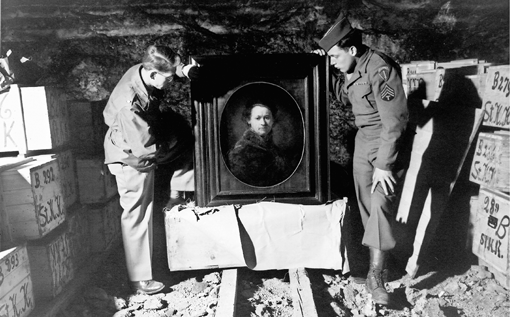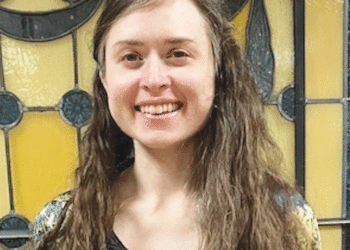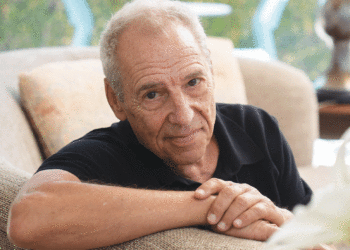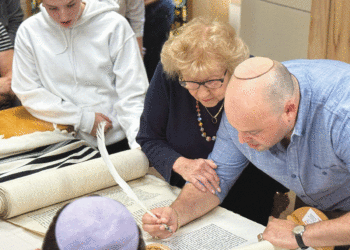Robert Edsel, author of The Monuments Men, went from the oil business to art history
By ERIN ELLIOTT BRYAN / Community News Editor
In February, Columbia Pictures and Twentieth Century Fox released The Monuments Men, which was written and directed by George Clooney.
Clooney also starred in the film as Frank Stokes, a member of a military unit during World War II that was tasked with protecting artistic masterpieces from damage during battle, as well as finding and rescuing pieces looted by the Nazis.
“You can wipe out an entire generation, you can burn their homes to the ground and somehow they’ll still find their way back,” Stokes says in the film. “But if you destroy their history, you destroy their achievements and it’s as if they never existed. That’s what Hitler wants and that’s exactly what we are fighting for.”
Robert Edsel:
Sept. 12 at Temple Israel
The film was based on Robert Edsel’s book titled The Monuments Men: Allied Heroes, Nazi Thieves, and the Greatest Treasure Hunt in History. Edsel will be the featured speaker for Temple Israel’s seventh annual Holocaust Remembrance Program on Sept. 12.
“These works of art that we enjoy — in museums and churches, synagogues — they haven’t survived by accident,” Edsel told the AJW in a phone interview last week, during his travels in Switzerland. “It’s happened because, in the case of works of art, other people who came before us made tremendous sacrifices to make sure these things survived for future generations.”

The Monuments Men were part of the Monuments, Fine Arts and Archives (MFAA) program under the Civil Affairs and Military Government Sections of the Allied armies, which was established in 1943. Edsel says there were approximately 350 Monuments Men from 13 different nations, though that many never served at one time.
Researching the work of those who served has been Edsel’s passion for the last 15 years. He grew up in Dallas, Texas, and was a former nationally ranked tennis player before finding success in the oil and gas exploration business.
Edsel’s company, Gemini Exploration, pioneered the use of horizontal drilling technology throughout the early 1990s. He sold the company’s assets to Union Pacific Resources Company in 1995 and moved with his family to Europe the following year — first to Paris and then to Florence, Italy, where he embraced the opportunity to study art and art history, which he describes as a “longstanding interest.”
“What else do you do in Florence?” Edsel said. “I had the time to do it.”
During his studies, Edsel kept coming back to one nagging question: How did so many works of art survive in the face of the most destructive war in history?

“I started asking people who I’d made friends with who lived in Europe, and they all said, ‘I don’t know, that’s a great question,’ and asked me what the answer was. I said, ‘Well, I don’t know, but you should know, you all live here,’” Edsel said. “World War II is the most documented, photographed, written-about event in history. And it was astonishing to me, as I started doing some research, purely as a pedestrian wanting to know the answer to this seemingly simple question. The more I dug into it, the more elusive the answer was, which seemed counterintuitive, given all the documentation. It was just a story that got lost in the fog of history.”
Edsel’s research into the work of the Monuments Men became more in-depth and, according to his online biography, became a “full-time job” by 2001. He felt compelled to share the story after the United States invaded Iraq in 2003.
“We all watched with great dismay the poor handling by the United States of the effort to protect the cultural treasures in Iraq,” Edsel said. “It was apparent to me that not only was this story fascinating and important to know from a historical standpoint, but it also held all these lessons that we’d forgotten or never learned since World War II.”
The Monuments Men did their work with no technological tools and very few resources — many hitchhiked across Europe — and two were killed in combat. Over the course of his research, Edsel has interviewed 18 Monuments Men, including two women.
His first book was Rescuing Da Vinci, published in 2006. The Monuments Men was published in 2009, followed by Saving Italy: The Race to Rescue a Nation’s Treasures from the Nazis in 2013. Edsel also published Nancy Yeide’s Beyond the Dreams of Avarice: The Hermann Goering Collection and was a co-producer of the documentary The Rape of Europa (5-30-08 AJW).
Additionally, Edsel is the founder and chairman of the board for the Monuments Men Foundation for the Preservation of Art, a not-for-profit organization that preserves the legacy of the Monuments Men and works to return looted artworks to their rightful heirs. The organization was awarded a National Humanities Medal from President George W. Bush in 2007.
Today, there are only six living Monuments Men. The youngest is 88 years old.
“Unfortunately, so much of the time has passed for so many of these monuments officers to say thank you personally,” Edsel said, “but we can do so by respecting their legacy and putting it to use.”
***
Temple Israel will present Robert Edsel, author of The Monuments Men: Allied Heroes, Nazi Thieves, and the Greatest Treasure Hunt in History, as the featured speaker for its seventh annual Holocaust Remembrance Program on Friday, Sept. 12 at the synagogue, 2324 Emerson Ave. S., Minneapolis. Edsel will speak from the bima during 6 p.m. services and present a lecture at 8 p.m., which is free and open to all.
Book sales and signing will follow the lecture. Reservations are required for a 7:15 p.m. Shabbat buffet dinner; cost is $30 per person.
For information, contact Wendy Schwartz at 612-374-0344 or: wendy@templeisrael.com.
For information on Edsel’s work, visit: www.monumentsmen.com.
(American Jewish World, 8.29.14)



















